Well everyone, this is it... the new blog.
I've ported over some of the articles worth saving from the old Petra'sTech blog (all tagged "PT Archive '08") and have forwarded the old URL. As of today, the Petra'sTech blog is no more... as of today, there is only www.CCTblog.com. Needless to say, CCTblog is going to be different from the old Petra'sTech blog in that it won't really have anything to do with Petra's Tech Shop and, instead, is going to be a mix of news, reviews, and commentary aimed at both computer enthusiasts and the automotive industry (with the occasional random tidbit tossed in). Despite the change, I will be keeping my existing Twitter and YouTube username to make things easier on everyone.
Sit back, relax, and enjoy the ride. =)
Saturday, October 3, 2009
[PT Archive '08]: PT Quick Tip: Making an external CMOS clear switch
I've been tinkering with my main system again... This time around, I figured that I'd show off a simple but very handy modification: a home made external CMOS clear switch.
Okay, let's be honest, how many of you are sick of ripping your case open to mess around with jumpers every time you start overclocking and have to reset the BIOS (clear CMOS)? How many of you, like me, can't even get at the jumper because of all the junk in your case? Well, there is a stupid-simple solution (and it's cheap!)...
First off, you'll need a switch (I just used one of the PCI bracket switches from a CCFL kit), some wire, a connector to stick onto the CMOS clear header (I used the wire from a case's power LED), some solder, a soldering iron, wire strippers, and some heatshrink.
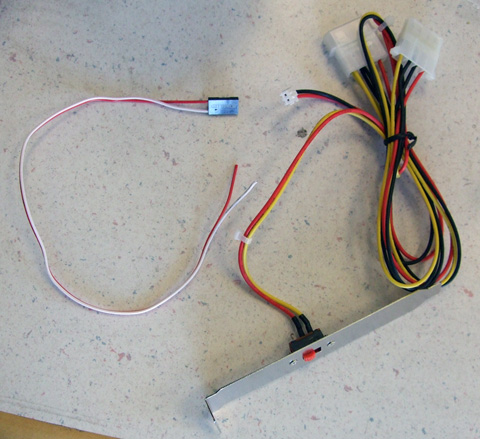
(click to enlarge)
The next steps are pretty simple...
- Trim wires to length and test fit everything
- Solder the wires together (and make sure to cover your solder joints with heatshrink tubing)
- Label the switch (for mine, I labeled one side 'N/O' (normally open) and the other 'Clr CMOS')
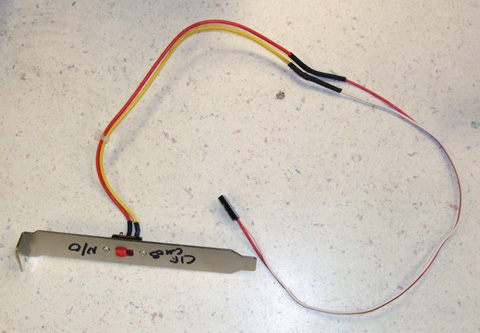
(click to enlarge)
Some important things to note:
I'm using a Gigabyte motherboard, so my CMOS clear header is only a 2-pin on/off kind of deal (which makes this mod very simple). For motherboards that utilize 3-pin CMOS clear headers, you'll need a 3rd wire to hook into your connector. Wiring is simple: the header's center pin should be linked to the switch's center terminal and the other two pins join with either of the two remaining outer terminals on the switch (order it to match the direction that you'd like the switch to operate). Depending on the motherboard in question, the third wire may not be necessary... but, unless you're familiar with the circuit design for the CMOS clear header, it's probably best to just use the 3rd wire anyway.
Next, you install the bracket, run the wire through the case, and connect it to the board's CMOS clear header.
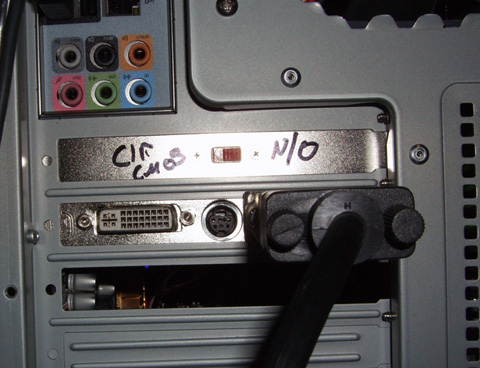
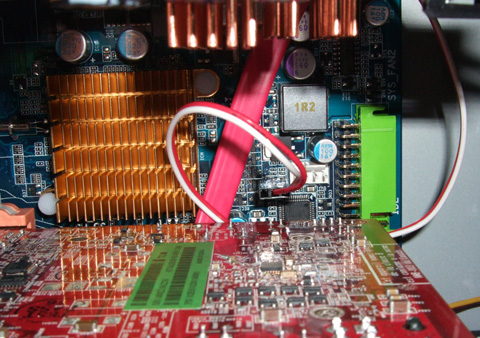
(click to enlarge)
...it's that simple.
Also, for those who were wondering, it is possible to cram two loops into the top portion of an Antec P180 (reservoirs mount to the case door with velcro):
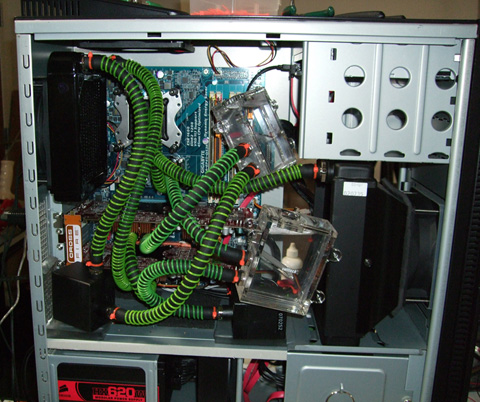
(click to enlarge)
...but a single loop is a lot cleaner (even if it isn't particularly well planned out because it's just a quick conversion of the dual loop setup).
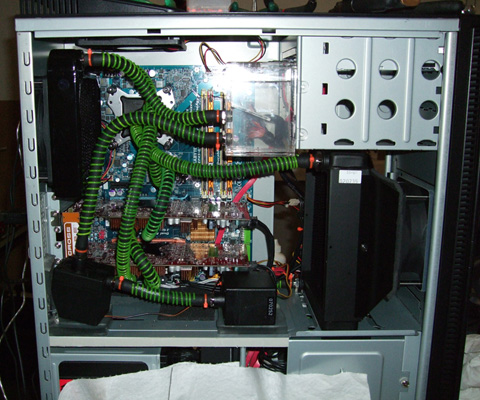
(click to enlarge)
This system's aim is low-noise performance, as all of the fans (except for the 1000RPM Scythe Ultra Kaze in the front) are 800RPM Scythe S-Flex SFF21D fans and the pumps are D-Tek dB-1's ... cooling an E8400, P45 northbridge, and two ATi HD4850's in CrossFire.
Okay, let's be honest, how many of you are sick of ripping your case open to mess around with jumpers every time you start overclocking and have to reset the BIOS (clear CMOS)? How many of you, like me, can't even get at the jumper because of all the junk in your case? Well, there is a stupid-simple solution (and it's cheap!)...
First off, you'll need a switch (I just used one of the PCI bracket switches from a CCFL kit), some wire, a connector to stick onto the CMOS clear header (I used the wire from a case's power LED), some solder, a soldering iron, wire strippers, and some heatshrink.

The next steps are pretty simple...
- Trim wires to length and test fit everything
- Solder the wires together (and make sure to cover your solder joints with heatshrink tubing)
- Label the switch (for mine, I labeled one side 'N/O' (normally open) and the other 'Clr CMOS')

Some important things to note:
I'm using a Gigabyte motherboard, so my CMOS clear header is only a 2-pin on/off kind of deal (which makes this mod very simple). For motherboards that utilize 3-pin CMOS clear headers, you'll need a 3rd wire to hook into your connector. Wiring is simple: the header's center pin should be linked to the switch's center terminal and the other two pins join with either of the two remaining outer terminals on the switch (order it to match the direction that you'd like the switch to operate). Depending on the motherboard in question, the third wire may not be necessary... but, unless you're familiar with the circuit design for the CMOS clear header, it's probably best to just use the 3rd wire anyway.
Next, you install the bracket, run the wire through the case, and connect it to the board's CMOS clear header.


...it's that simple.
Also, for those who were wondering, it is possible to cram two loops into the top portion of an Antec P180 (reservoirs mount to the case door with velcro):

...but a single loop is a lot cleaner (even if it isn't particularly well planned out because it's just a quick conversion of the dual loop setup).

This system's aim is low-noise performance, as all of the fans (except for the 1000RPM Scythe Ultra Kaze in the front) are 800RPM Scythe S-Flex SFF21D fans and the pumps are D-Tek dB-1's ... cooling an E8400, P45 northbridge, and two ATi HD4850's in CrossFire.
Labels:
tech
[PT Archive '08]: A Quick Peek at the Asus HD4850
That's right, I've decided to give ATi another go--I really hope that I don't end up disappointed (though, with as cheap as these cards are, I'm not sure that I could be).
I was reading through some reviews last week and decided that picking up a couple HD4850 cards (about $160 each after rebates from the Egg) would be a pretty good replacement for my aging 8800GTX... so I placed my order and waited patiently. The cards arrived yesterday (hopefully I'll have a chance to mess around with them a bit today) and I figured that I may as well post some teaser pics and complain about Asus' Apple-esque use of packaging. On with the pics!
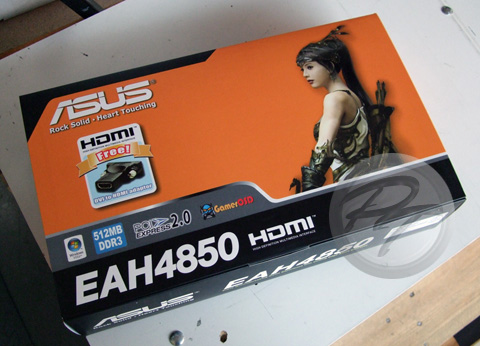
And what do we have here? ...black, orange, and a CG Asian combat-chick all wrapped around a 16" x 9.5" x 3.5" 3lb. box of pixel crunching goodness! I'm not sure what's with the CG chick/alien/wizard/space ship/whatever obsession that a lot of these companies seem to have, but at least Asus was a little more subtle about it this time around than some companies *cough*Gigabyte, Sapphire, and MSI*/cough*
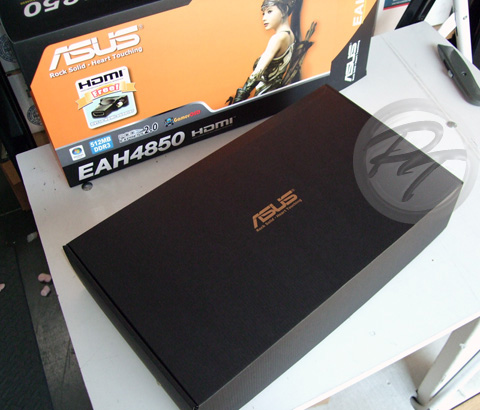
Opening things up a bit, I found a rock solid, heart touching black box...
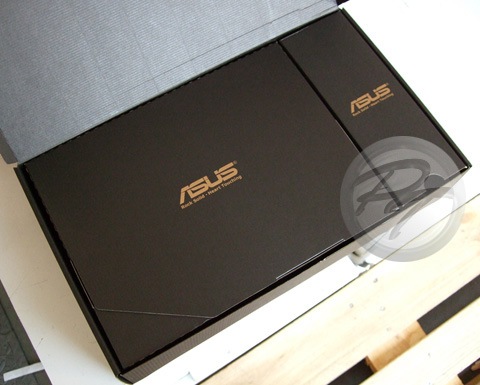
Oh, would you look at that... more Asus branded black boxes. I sense a trend forming here.
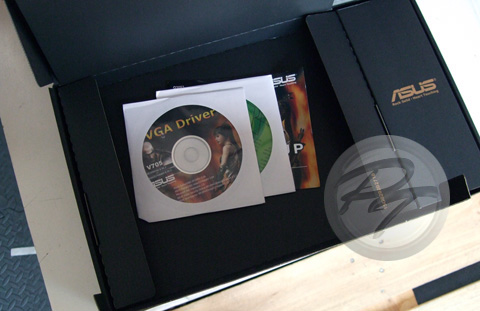
That's it? Two CDs and a tiny little booklet? I'm starting to think that the guys over at Asus spent all of their money on packaging and probably only had enough left over to manufacture video cards out of paper-macheé and candy corn.
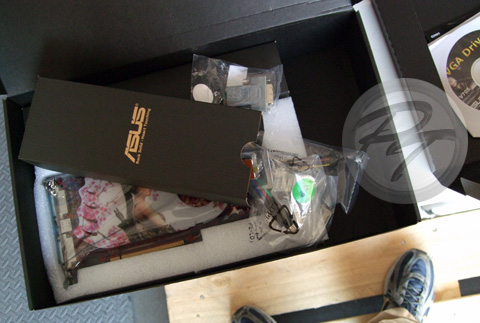
Uh, couldn't these parts fit into that other box...?
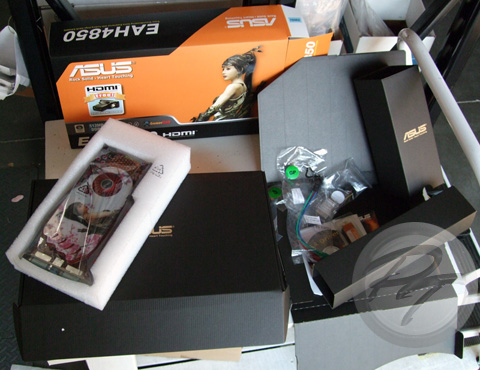
I understand Asus' desire to put forth a 'high-end' image but, seriously, this is a video card--put the money toward better components or something.
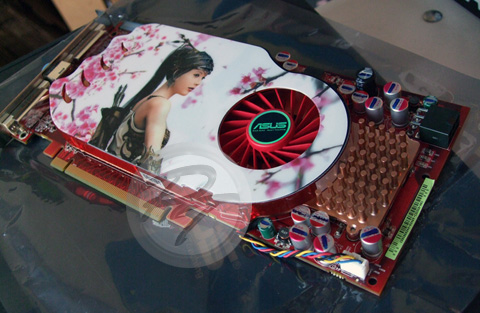
...and there's that Asus CG Asian combat-chick again surrounded by... are those cherry blossoms? In Taiwan?
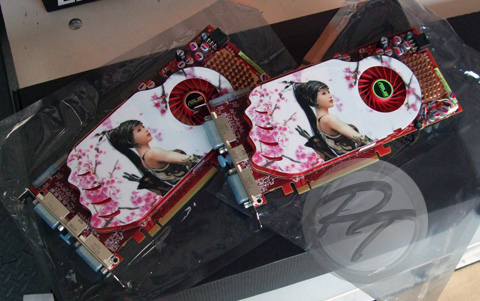
Twins! Or, perhaps, clones? Either way, they better play nice together and not pester my crotchety, old P5B.
Well, that's all for now... anybody need a spare 8800GTX? =)
I was reading through some reviews last week and decided that picking up a couple HD4850 cards (about $160 each after rebates from the Egg) would be a pretty good replacement for my aging 8800GTX... so I placed my order and waited patiently. The cards arrived yesterday (hopefully I'll have a chance to mess around with them a bit today) and I figured that I may as well post some teaser pics and complain about Asus' Apple-esque use of packaging. On with the pics!

And what do we have here? ...black, orange, and a CG Asian combat-chick all wrapped around a 16" x 9.5" x 3.5" 3lb. box of pixel crunching goodness! I'm not sure what's with the CG chick/alien/wizard/space ship/whatever obsession that a lot of these companies seem to have, but at least Asus was a little more subtle about it this time around than some companies *cough*Gigabyte, Sapphire, and MSI*/cough*

Opening things up a bit, I found a rock solid, heart touching black box...

Oh, would you look at that... more Asus branded black boxes. I sense a trend forming here.

That's it? Two CDs and a tiny little booklet? I'm starting to think that the guys over at Asus spent all of their money on packaging and probably only had enough left over to manufacture video cards out of paper-macheé and candy corn.

Uh, couldn't these parts fit into that other box...?

I understand Asus' desire to put forth a 'high-end' image but, seriously, this is a video card--put the money toward better components or something.

...and there's that Asus CG Asian combat-chick again surrounded by... are those cherry blossoms? In Taiwan?

Twins! Or, perhaps, clones? Either way, they better play nice together and not pester my crotchety, old P5B.
Well, that's all for now... anybody need a spare 8800GTX? =)
Labels:
tech
[PT Archive '08]: Fun With Coolants
The lengths that I'll go to in order to make a point... My quest against pre-mixed coolants marketed as "non-conductive" PC coolants continues and, this time around, I end up killing a couple motherboards. Video goodness ensues.
Okay, so it's a little late to the blog but better late than never. As a quick bit of lead-in, here's the YouTube description for this episode of PT Quick Clips (hopefully, this will turn into an ongoing video series):
Continuing my griping about "non-conductive" coolants and the marketing thereof, I've decided to have a little fun with a couple of motherboards, some "non-conductive" coolant, and a bottle of distilled water.
It's important to note that all of the components used were thoroughly cleaned with clean air, 99.9% IPA, and contact cleaner prior to taking a bath. The two motherboards were brand new Abit IB9's and the catch tray was cleaned with soapy water, rinsed with distilled water, rinsed with 99.9% IPA, and allowed to dry before each "test".
*Update* After letting both boards dry and cleaning them thoroughly, neither of them function--don't spill things on your motherboard!"
Okay, so it's a little late to the blog but better late than never. As a quick bit of lead-in, here's the YouTube description for this episode of PT Quick Clips (hopefully, this will turn into an ongoing video series):
Continuing my griping about "non-conductive" coolants and the marketing thereof, I've decided to have a little fun with a couple of motherboards, some "non-conductive" coolant, and a bottle of distilled water.
It's important to note that all of the components used were thoroughly cleaned with clean air, 99.9% IPA, and contact cleaner prior to taking a bath. The two motherboards were brand new Abit IB9's and the catch tray was cleaned with soapy water, rinsed with distilled water, rinsed with 99.9% IPA, and allowed to dry before each "test".
*Update* After letting both boards dry and cleaning them thoroughly, neither of them function--don't spill things on your motherboard!"
[PT Archive '08]: Yahtzee Talks Water Cooling... well, not really.
This week's episode of Zero Punctuation is a little different than usual and touches upon a phenomena which goes far beyond the realm of computer games...
First thing's first... watch the video:
So, did you catch it? Here's a tip: it has to do with the letter from Cpt. James Obvious.
Okay, time's up... I'm not going to sit here waiting for everyone to figure it out. In this video, Yahtzee touches upon people's desire/need for some sort of authoritative approval of something (be it a video game, waterblock, bookend, or toilet seat) before being able to justify its purchase or, in some instances, its existence. In addition, he mentions people's issues with "reviews" that don't boil all of their content down into some meaningless numerical value that can be directly compared to anything and everything else. See where I'm going with this yet?
Now, I'd probably be better equipped to express all of this if it weren't so late, but I'll give it a go anyway... It is the job, nay, the duty of a hardware reviewer to be a critic, to find a product's faults, and to carefully balance their criticism with mentionings of a product's more positive aspects (if any exist). Tragically, it's this balance that's missing from most tech sites (and "reviewers") these days, as most seem to have turned to little more than shills for product manufacturers in an effort to ensure an uninterrupted stream of junk for them to beam over... all the while, racking up clicks and impressions for their paying advertisers. Personally, I tend to err on the side of overly criticizing a product or product manufacturer, as opposed to making everything out to be the best thing since sliced bread--I suppose that I'm just strange. Anyway, getting back on track, I've been seeing more and more of people shunning credible, comprehensive analysis of a given product in favor of half-baked, utterly useless reviews blathering on about how great something is. The reason: because they're simpler. If a person doesn't understand the information and commentary that's being presented, they tune out and go look for some black & white "review" written by another half-wit that just tells them what to buy regardless of whether or not it's really the best option for the individual. If you ask me, I'd expect people to go out and LEARN the basic information required to understand the better review--sounds reasonable enough, doesn't it? After all, things like computer cooling really aren't complicated... and if you understand the basics, then you can actually make educated decisions about what is best for you *gasp*! Though, with the sheer volume of misinformation floating around in forums and such, I can't help but wonder if I'm expecting too much (a truly disheartening thought). Has the passion for knowledge and understanding died in so many?
First thing's first... watch the video:
So, did you catch it? Here's a tip: it has to do with the letter from Cpt. James Obvious.
Okay, time's up... I'm not going to sit here waiting for everyone to figure it out. In this video, Yahtzee touches upon people's desire/need for some sort of authoritative approval of something (be it a video game, waterblock, bookend, or toilet seat) before being able to justify its purchase or, in some instances, its existence. In addition, he mentions people's issues with "reviews" that don't boil all of their content down into some meaningless numerical value that can be directly compared to anything and everything else. See where I'm going with this yet?
Now, I'd probably be better equipped to express all of this if it weren't so late, but I'll give it a go anyway... It is the job, nay, the duty of a hardware reviewer to be a critic, to find a product's faults, and to carefully balance their criticism with mentionings of a product's more positive aspects (if any exist). Tragically, it's this balance that's missing from most tech sites (and "reviewers") these days, as most seem to have turned to little more than shills for product manufacturers in an effort to ensure an uninterrupted stream of junk for them to beam over... all the while, racking up clicks and impressions for their paying advertisers. Personally, I tend to err on the side of overly criticizing a product or product manufacturer, as opposed to making everything out to be the best thing since sliced bread--I suppose that I'm just strange. Anyway, getting back on track, I've been seeing more and more of people shunning credible, comprehensive analysis of a given product in favor of half-baked, utterly useless reviews blathering on about how great something is. The reason: because they're simpler. If a person doesn't understand the information and commentary that's being presented, they tune out and go look for some black & white "review" written by another half-wit that just tells them what to buy regardless of whether or not it's really the best option for the individual. If you ask me, I'd expect people to go out and LEARN the basic information required to understand the better review--sounds reasonable enough, doesn't it? After all, things like computer cooling really aren't complicated... and if you understand the basics, then you can actually make educated decisions about what is best for you *gasp*! Though, with the sheer volume of misinformation floating around in forums and such, I can't help but wonder if I'm expecting too much (a truly disheartening thought). Has the passion for knowledge and understanding died in so many?
Labels:
musings
[PT Archive '08]: Review: Mini Air Cooler Roundup
Hey everybody! As I've mentioned in our forums, I've been working on getting my CPU waterblock testbed together and have decided to toss some air coolers onto it for evaluation. On the bench this time around is the Thermalright Ultra 120 Extreme, IFX-14, the Scythe Orochi, Copper Ninja, and old Ninja. The results of all of this time spent testing are somewhat surprising... read on for more!
Rather than bore you with a bunch of introductory garbage and photos talking about colorful packaging and poorly written instructions, I think that I'll just jump right into things.
Testing Methodology and Information:
I'm using a modified E6400 as a heat source (basically, I've had the IHS milled according to Intel's TTV specifications and embedded a very tiny T-type thermocouple into the IHS). The thermocouple that's embedded in the CPU's IHS provides me with what Intel defines as a Tcase temperature (which is the temperature of the geometric center of the IHS, a certain distance below the surface). Now, this temperature is always lower than the measured "die temperature" (partially because it's not taking into account the temperature rise incurred by the TIM joint between the die and inside of the IHS) but I'm able to calibrate the thermocouple with all of my other probes. I like this approach because it doesn't feel like I'm flying blind--all data is coming from known, calibrated probes that all behave in the same, predictable manner and can be logged by the same measuring device. Plus, I've had issues with temperature deltas obtained with TAT being adversely affected by ambient temperature...which isn't something that should happen and, when it does, it wreaks havoc on repeatability and accuracy (I've mentioned this on XS before and will be looking into the matter further before moving on to waterblock evaluation).
In addition to the Franken-E6400, an Omega T-type thermocouple (that nice, long probe that can be seen in the photo below) is being used to measure what I'll refer to as the 'air inlet' temperature. This probe is positioned one inch from the center of the fan's hub (or hestsink surface, in the case of the IFX-14), on the inlet side for all tests. Both the air inlet probe and "TTV" probe are connected to an Extech EA15 data logging thermometer, which is configured to simultaneously record data from each probe and calculate the temperature difference between the probes (deltaT) every two seconds. Each heatsink was mounted three times and tested with two fans (the Scythe S-Flex SFF21D and SFF21F, rated at 33.5 CFM (8.7 dBA) and 63.7 CFM (28 dBA) respectively). The Scythe S-Flex "D" and "F" fans were chosen due to their fantastic noise to airflow ratio, minimal bearing noise, and long MTBF rating.
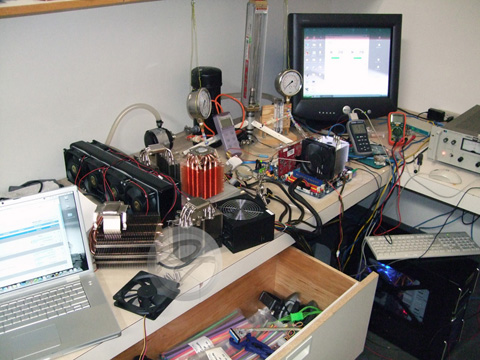
(click to enlarge)
With the CPU set to 1.55V in BIOS (1.504V after droop, at load) and running at 2133MHz, each heatsink was allowed a 30 minute warm-up period (using Intel's TAT to load the CPU) before I began the 15 minute data collection runs (the first five minutes of which being removed before averaging data). The heatsinks were allowed to cool between trials and the fan mounted to the heatsink was kept at 12.00V throughout testing with the use of our trusty HP 6264B variable DC PSU. As a result of all of this, each of the bars on the results graph below represents the mean of 900 points of data spread across three trials (three mounts).
While this test setup is adequate, it's far from perfect. Some of the unknowns/variables include the following:
• Airflow: The fans, while kept at 12.00V, are not providing the same amount of airflow through each heatsink tested (for those who don't know, the volumetric airflow output of a cooling fan, just like a water pump, is dependent upon the pressure at which the fan operates and each heatsink, like a waterblock, will incur a different operating pressure). To actually get the same volume of air through a heatsink during a given test, like I would do with water through a waterblock, I'd need to construct some sort of chamber around the heatsink which would allow me to measure airflow (when combined with the proper equipment) and make adjustments by altering fan voltage.
• Mounting hardware and the pressure applied by said hardware: Unlike waterblocks, for which it's rather easy to put together a uniform mounting system, air coolers are very difficult to work with when it comes to controlling mounting load and making sure that the load is equal across all heatsinks tested--much of this comes from how radically different the basic mounting hardware design can be from unit to unit. As such, I had to test each heatsink with whatever mounting hardware the manufacturer included...and it definitely appeared like Thermalright took the cake as far as applied mounting load is concerned.
• Heat applied to the device under test (DUT): While it isn't terribly important from a comparative standpoint (since approximately the same amount of heat should have been produced by the CPU during each trial), I don't actually know how much heat was being applied to each heatsink during testing, especially if you take secondary losses into account. Based on some research that Swiftech did a while back, I'd guesstimate the heat applied to the DUT during each trial to be around 62W (69W less 10% to account for secondary losses, with the percentage being little more than a guess). For waterblock testing, I should be able to bring the system up to somewhere around 100W but I found the settings to be poorly suited to heatsink testing due to system instability. Granted, all of this doesn't take into account potential thermal output differences between the Conroe and Allendale cores, despite them having the same Intel-rated TDP... and I'm assuming that Swiftech got things right ;-)
• General mount variation and differences in TIM application: An issue with all heatsink/waterblock testing, carefully mounting each unit three times and averaging the data from each test should help to provide a somewhat accurate depiction of performance despite these variables. It also helps that I've gotten quite good at applying ArcticSilver's Ceramique TIM in layers so thin that they're semi-translucent and very similar in quantity and distribution each time--repeatability is more important than TIM performance, for those of you who would question the use of Ceramique on the grounds of it not being the best performing.
Testing Results, Analysis, and Commentary:
Well, I said that I wouldn't bore you with introductory stuff... instead, I went for technical junk :P
At this point, I think that I'll grant you a reprieve and present unto you a pretty bar graph:
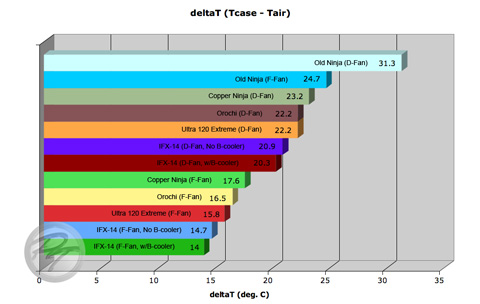
(click to enlarge)
Now, as you can see above, the Thermalright IFX-14 is the clear performance leader, with the old Ninja trailing a lot farther behind than I would have hoped. It's pretty safe to assume that the performance rankings would be about the same if a higher heat load were to be applied, with the performance gap between the coolers increasing proportionally. If all of this deltaT stuff is confusing you and you find yourself banging your head on a table pleading for "real numbers" from TAT, then just add your current room temperature to the above temperature delta and tack on about ten degrees to the total. The fun does not end there, though! I still have to rant about what's wrong with all of these coolers (aside from them being air coolers).
The Old Scythe Ninja (Rev. B street price: ~$37): When it was released, it was a pretty spiffy heatsink... however, time has marched on and heatsink design progressed. I have to say that I'm rather disappointed, especially considering that something as simple as increasing the mounting pressure/quality (take a hint from Thermalright) and spacing the heatpipes out (like was done to the Ninja Mini and Copper Ninja) would likely yield a substantial performance boost. To clarify, I was using the older Scythe Ninja with the 4-clip mount and backplate rather than the "newer" version that employs those damn stupid plastic push-pins (identical to the stock Intel cooler). Seriously, there are few better ways to molest a motherboard than to use plastic push-pins to attach a large cooler. They have no place on a performance-oriented product--make them disappear. Plastic push-pin mounts are the reason that I did not test the Infinity/Mugen, despite it being an otherwise fine cooler. Anyway, overall, the Scythe Ninja isn't that bad of a cooler when you take into consideration its <$40 price tag.
Scythe Copper Ninja (street price: ~$65): The Copper Ninja did a fine job of keeping up with the rest of the pack and, as I pointed out above, I attribute much of the performance gain over the old Ninja to the spaced heatpipes--all that copper does look cool, though. I don't really have any complaints about the cooler that I haven't already gone over, aside from the typical Scythe backplate-o-doom. Tip: do NOT remove the protective backing from the adhesive side of a Scythe backplate before use. If you do, then you will likely never be able to remove the backplate from your motherboard without causing damage.
Scythe Orochi (street price: ~$65-$80): With 'Orochi', if I remember correctly, meaning 'serpent' in Japanese, I can't help but find myself wondering whether 'Anaconda' would have been more appropriate. Simply put, this heatsink is enormous--so large, I would have hoped it to be a good rival for the IFX-14. Alas, the Orochi just could not keep up with Thermalright's flagship mess of fire extinguishing pointiness. The Orochi does have some redeeming qualities, though... it appears to be a fantastic passive/semi-passive cooler for those of you who aren't really overclocking. In a random fit of curiosity, I attempted to bring my test CPU up to its thermal shutdown point using the heatsink without a fan and the only way that I was able to succeed within a reasonable amount of time was to cover the whole heatsink in cardboard and aim a heat gun into my newly constructed cardboard shack. It probably would have overheated eventually without the help of my heat gun... but I didn't feel like waiting. An important thing to note, however, would be that this heatsink covers your RAM. While that may not be an issue for some, those of us who change our RAM out a lot or use abnormally large DIMMs (Corsair Dominators, anyone?) are up a creek without a paddle--the size of the cooler could also pose a problem in some computer cases (especially if you have long optical drives).
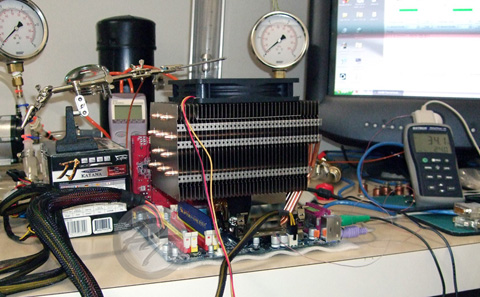
(click to enlarge)
Thermalright Ultra 120 Extreme (street price: ~$57): Clean, minimalist design, fantastic performance, and a price point to die for--this heatsink has it all. Granted, I should probably mention the bit about the mounting hardware dumping little metal flakes on my motherboard and the top fin breaking loose due to repeated installation and fan mounting. I really can't think of much more to say about this great, no-nonsense, performance heatsink.
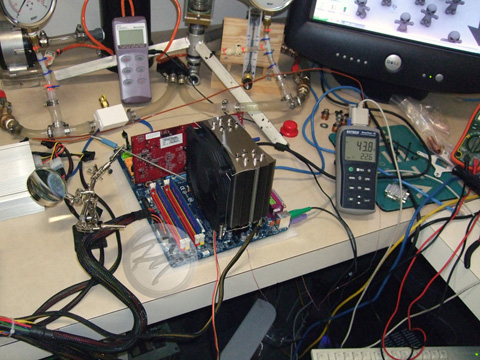
(click to enlarge)
Thermalright Inferno Fire Extinguisher [IFX] 14 (street price: ~$70): It may be the performance leader, but I have a few complaints... Aside from it being big, gaudy (I can't stand the flame-fin thing), and somewhat irritating to work with, it has some compatibility and possible QC issues. As shown in the photos below, the mounting hardware collided with my test board's northbridge heatsink and a capacitor near the CPU socket (tweaking both), the backplate could only be installed in an orientation that caused the backside cooler to extend beyond the board's I/O cluster (not only do you have to worry about case compatibility with that backside cooler, but motherboard layout as well), the unit visibly bows the motherboard when the backside cooler is installed, and the base of this heatsink is so far from flat that it was laughable (though, I think that it may have helped the performance a bit...my issue is with whether or not it was intentional).
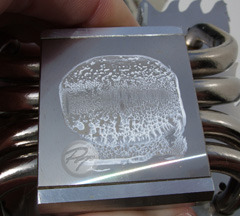
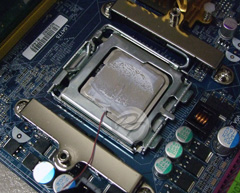
(click to enlarge)
The base of this heatsink is bad enough to where I can rock a razor blade across its surface... However, based on the TIM and contact distribution examples above, it appears that the deformity (high spot) ran right down the center of the heatsink's base and, coincidentally, right across the center of the CPU package. Now, I don't think that the deformity was intentional since no other reviews that I came across mentioned it, but it may have helped the overall performance of the unit similar to the gains that have been seen by bowing/stepping CPU waterblocks. It almost makes me want to have the shop lap the heatsink's base flat so that I can re-test it and see what sort of performance difference results... almost. Anyway, I suppose that the moral of the story is that you shouldn't use the IFX-14 with a Gigabyte 965P-DS3.
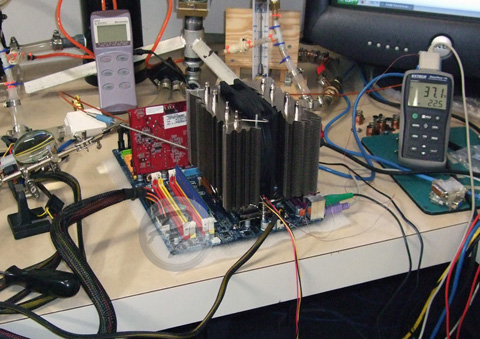
(click to enlarge)
Conclusion:
Everybody already knows this but I'm going to say it anyway... Of the performance heatsinks available, the Thermalright Ultra 120 Extreme represents what is likely the best value for the money. Having both best performing heatsink and the best price:performance heatsink in their pocket, Thermalright can now go back to updating their HR-09 MOSFET cooler compatibility charts.
Scythe, on the other hand, needs to decide what market segment they're trying to cater to. Looking at their heatsink offerings and the compromises that keep being made which, frankly, water down their more performance-oriented parts (e.g. mounting hardware), they seem to be straddling the fence with one leg dangling in the novelty cooler segment and the other desperately seeking the sweet solidity of terra firma in the performance cooler market segment. The result of this indecision being a few solid but somewhat identity-confused products and a few products, like the Kama Cross, which should have never been allowed to see the light of day. I must say, though, the build quality of their coolers is always fantastic and the standard deviation of the data collected for the Scythe heatsinks was lower and more consistent than that of the Thermalright heatsinks.
Rather than bore you with a bunch of introductory garbage and photos talking about colorful packaging and poorly written instructions, I think that I'll just jump right into things.
Testing Methodology and Information:
I'm using a modified E6400 as a heat source (basically, I've had the IHS milled according to Intel's TTV specifications and embedded a very tiny T-type thermocouple into the IHS). The thermocouple that's embedded in the CPU's IHS provides me with what Intel defines as a Tcase temperature (which is the temperature of the geometric center of the IHS, a certain distance below the surface). Now, this temperature is always lower than the measured "die temperature" (partially because it's not taking into account the temperature rise incurred by the TIM joint between the die and inside of the IHS) but I'm able to calibrate the thermocouple with all of my other probes. I like this approach because it doesn't feel like I'm flying blind--all data is coming from known, calibrated probes that all behave in the same, predictable manner and can be logged by the same measuring device. Plus, I've had issues with temperature deltas obtained with TAT being adversely affected by ambient temperature...which isn't something that should happen and, when it does, it wreaks havoc on repeatability and accuracy (I've mentioned this on XS before and will be looking into the matter further before moving on to waterblock evaluation).
In addition to the Franken-E6400, an Omega T-type thermocouple (that nice, long probe that can be seen in the photo below) is being used to measure what I'll refer to as the 'air inlet' temperature. This probe is positioned one inch from the center of the fan's hub (or hestsink surface, in the case of the IFX-14), on the inlet side for all tests. Both the air inlet probe and "TTV" probe are connected to an Extech EA15 data logging thermometer, which is configured to simultaneously record data from each probe and calculate the temperature difference between the probes (deltaT) every two seconds. Each heatsink was mounted three times and tested with two fans (the Scythe S-Flex SFF21D and SFF21F, rated at 33.5 CFM (8.7 dBA) and 63.7 CFM (28 dBA) respectively). The Scythe S-Flex "D" and "F" fans were chosen due to their fantastic noise to airflow ratio, minimal bearing noise, and long MTBF rating.

With the CPU set to 1.55V in BIOS (1.504V after droop, at load) and running at 2133MHz, each heatsink was allowed a 30 minute warm-up period (using Intel's TAT to load the CPU) before I began the 15 minute data collection runs (the first five minutes of which being removed before averaging data). The heatsinks were allowed to cool between trials and the fan mounted to the heatsink was kept at 12.00V throughout testing with the use of our trusty HP 6264B variable DC PSU. As a result of all of this, each of the bars on the results graph below represents the mean of 900 points of data spread across three trials (three mounts).
While this test setup is adequate, it's far from perfect. Some of the unknowns/variables include the following:
• Airflow: The fans, while kept at 12.00V, are not providing the same amount of airflow through each heatsink tested (for those who don't know, the volumetric airflow output of a cooling fan, just like a water pump, is dependent upon the pressure at which the fan operates and each heatsink, like a waterblock, will incur a different operating pressure). To actually get the same volume of air through a heatsink during a given test, like I would do with water through a waterblock, I'd need to construct some sort of chamber around the heatsink which would allow me to measure airflow (when combined with the proper equipment) and make adjustments by altering fan voltage.
• Mounting hardware and the pressure applied by said hardware: Unlike waterblocks, for which it's rather easy to put together a uniform mounting system, air coolers are very difficult to work with when it comes to controlling mounting load and making sure that the load is equal across all heatsinks tested--much of this comes from how radically different the basic mounting hardware design can be from unit to unit. As such, I had to test each heatsink with whatever mounting hardware the manufacturer included...and it definitely appeared like Thermalright took the cake as far as applied mounting load is concerned.
• Heat applied to the device under test (DUT): While it isn't terribly important from a comparative standpoint (since approximately the same amount of heat should have been produced by the CPU during each trial), I don't actually know how much heat was being applied to each heatsink during testing, especially if you take secondary losses into account. Based on some research that Swiftech did a while back, I'd guesstimate the heat applied to the DUT during each trial to be around 62W (69W less 10% to account for secondary losses, with the percentage being little more than a guess). For waterblock testing, I should be able to bring the system up to somewhere around 100W but I found the settings to be poorly suited to heatsink testing due to system instability. Granted, all of this doesn't take into account potential thermal output differences between the Conroe and Allendale cores, despite them having the same Intel-rated TDP... and I'm assuming that Swiftech got things right ;-)
• General mount variation and differences in TIM application: An issue with all heatsink/waterblock testing, carefully mounting each unit three times and averaging the data from each test should help to provide a somewhat accurate depiction of performance despite these variables. It also helps that I've gotten quite good at applying ArcticSilver's Ceramique TIM in layers so thin that they're semi-translucent and very similar in quantity and distribution each time--repeatability is more important than TIM performance, for those of you who would question the use of Ceramique on the grounds of it not being the best performing.
Testing Results, Analysis, and Commentary:
Well, I said that I wouldn't bore you with introductory stuff... instead, I went for technical junk :P
At this point, I think that I'll grant you a reprieve and present unto you a pretty bar graph:

Now, as you can see above, the Thermalright IFX-14 is the clear performance leader, with the old Ninja trailing a lot farther behind than I would have hoped. It's pretty safe to assume that the performance rankings would be about the same if a higher heat load were to be applied, with the performance gap between the coolers increasing proportionally. If all of this deltaT stuff is confusing you and you find yourself banging your head on a table pleading for "real numbers" from TAT, then just add your current room temperature to the above temperature delta and tack on about ten degrees to the total. The fun does not end there, though! I still have to rant about what's wrong with all of these coolers (aside from them being air coolers).
The Old Scythe Ninja (Rev. B street price: ~$37): When it was released, it was a pretty spiffy heatsink... however, time has marched on and heatsink design progressed. I have to say that I'm rather disappointed, especially considering that something as simple as increasing the mounting pressure/quality (take a hint from Thermalright) and spacing the heatpipes out (like was done to the Ninja Mini and Copper Ninja) would likely yield a substantial performance boost. To clarify, I was using the older Scythe Ninja with the 4-clip mount and backplate rather than the "newer" version that employs those damn stupid plastic push-pins (identical to the stock Intel cooler). Seriously, there are few better ways to molest a motherboard than to use plastic push-pins to attach a large cooler. They have no place on a performance-oriented product--make them disappear. Plastic push-pin mounts are the reason that I did not test the Infinity/Mugen, despite it being an otherwise fine cooler. Anyway, overall, the Scythe Ninja isn't that bad of a cooler when you take into consideration its <$40 price tag.
Scythe Copper Ninja (street price: ~$65): The Copper Ninja did a fine job of keeping up with the rest of the pack and, as I pointed out above, I attribute much of the performance gain over the old Ninja to the spaced heatpipes--all that copper does look cool, though. I don't really have any complaints about the cooler that I haven't already gone over, aside from the typical Scythe backplate-o-doom. Tip: do NOT remove the protective backing from the adhesive side of a Scythe backplate before use. If you do, then you will likely never be able to remove the backplate from your motherboard without causing damage.
Scythe Orochi (street price: ~$65-$80): With 'Orochi', if I remember correctly, meaning 'serpent' in Japanese, I can't help but find myself wondering whether 'Anaconda' would have been more appropriate. Simply put, this heatsink is enormous--so large, I would have hoped it to be a good rival for the IFX-14. Alas, the Orochi just could not keep up with Thermalright's flagship mess of fire extinguishing pointiness. The Orochi does have some redeeming qualities, though... it appears to be a fantastic passive/semi-passive cooler for those of you who aren't really overclocking. In a random fit of curiosity, I attempted to bring my test CPU up to its thermal shutdown point using the heatsink without a fan and the only way that I was able to succeed within a reasonable amount of time was to cover the whole heatsink in cardboard and aim a heat gun into my newly constructed cardboard shack. It probably would have overheated eventually without the help of my heat gun... but I didn't feel like waiting. An important thing to note, however, would be that this heatsink covers your RAM. While that may not be an issue for some, those of us who change our RAM out a lot or use abnormally large DIMMs (Corsair Dominators, anyone?) are up a creek without a paddle--the size of the cooler could also pose a problem in some computer cases (especially if you have long optical drives).

Thermalright Ultra 120 Extreme (street price: ~$57): Clean, minimalist design, fantastic performance, and a price point to die for--this heatsink has it all. Granted, I should probably mention the bit about the mounting hardware dumping little metal flakes on my motherboard and the top fin breaking loose due to repeated installation and fan mounting. I really can't think of much more to say about this great, no-nonsense, performance heatsink.

Thermalright Inferno Fire Extinguisher [IFX] 14 (street price: ~$70): It may be the performance leader, but I have a few complaints... Aside from it being big, gaudy (I can't stand the flame-fin thing), and somewhat irritating to work with, it has some compatibility and possible QC issues. As shown in the photos below, the mounting hardware collided with my test board's northbridge heatsink and a capacitor near the CPU socket (tweaking both), the backplate could only be installed in an orientation that caused the backside cooler to extend beyond the board's I/O cluster (not only do you have to worry about case compatibility with that backside cooler, but motherboard layout as well), the unit visibly bows the motherboard when the backside cooler is installed, and the base of this heatsink is so far from flat that it was laughable (though, I think that it may have helped the performance a bit...my issue is with whether or not it was intentional).


The base of this heatsink is bad enough to where I can rock a razor blade across its surface... However, based on the TIM and contact distribution examples above, it appears that the deformity (high spot) ran right down the center of the heatsink's base and, coincidentally, right across the center of the CPU package. Now, I don't think that the deformity was intentional since no other reviews that I came across mentioned it, but it may have helped the overall performance of the unit similar to the gains that have been seen by bowing/stepping CPU waterblocks. It almost makes me want to have the shop lap the heatsink's base flat so that I can re-test it and see what sort of performance difference results... almost. Anyway, I suppose that the moral of the story is that you shouldn't use the IFX-14 with a Gigabyte 965P-DS3.

Conclusion:
Everybody already knows this but I'm going to say it anyway... Of the performance heatsinks available, the Thermalright Ultra 120 Extreme represents what is likely the best value for the money. Having both best performing heatsink and the best price:performance heatsink in their pocket, Thermalright can now go back to updating their HR-09 MOSFET cooler compatibility charts.
Scythe, on the other hand, needs to decide what market segment they're trying to cater to. Looking at their heatsink offerings and the compromises that keep being made which, frankly, water down their more performance-oriented parts (e.g. mounting hardware), they seem to be straddling the fence with one leg dangling in the novelty cooler segment and the other desperately seeking the sweet solidity of terra firma in the performance cooler market segment. The result of this indecision being a few solid but somewhat identity-confused products and a few products, like the Kama Cross, which should have never been allowed to see the light of day. I must say, though, the build quality of their coolers is always fantastic and the standard deviation of the data collected for the Scythe heatsinks was lower and more consistent than that of the Thermalright heatsinks.
Labels:
reviews
Subscribe to:
Posts (Atom)